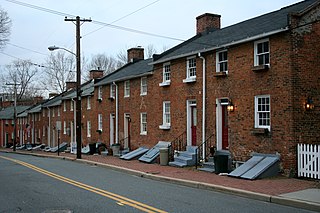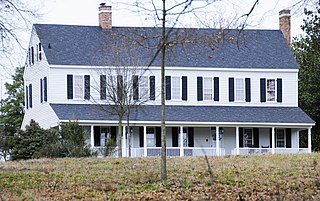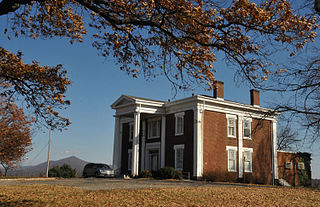
Buena Vista is an independent city located in the Blue Ridge Mountains region of Virginia in the United States. As of the 2020 census, the population was 6,641. The Bureau of Economic Analysis combines the independent cities of Buena Vista and Lexington, along with surrounding Rockbridge County, for statistical purposes.

Greer is a city in Greenville and Spartanburg counties in the U.S. state of South Carolina. The population was 35,308 as of the 2020 census Greer is part of the Greenville–Anderson–Mauldin Metropolitan Statistical Area. The city is additionally part of the Greenville-Spartanburg-Anderson, SC Combined Statistical Area in Upstate South Carolina.

Guilford is an unincorporated community located in Howard County in the state of Maryland. The location is named after the Guilford Mill. Guilford is near Kings Contrivance, one of the nine "villages" of Columbia.

Oella is a mill town on the Patapsco River in western Baltimore County, Maryland, United States, located between Catonsville and Ellicott City. It is a 19th-century village of millworkers' homes.

The Slater Mill is a historic water-powered textile mill complex on the banks of the Blackstone River in Pawtucket, Rhode Island, modeled after cotton spinning mills first established in England. It is the first water-powered cotton spinning mill in North America to utilize the Arkwright system of cotton spinning as developed by Richard Arkwright.

Musgrove Mill State Historic Site was the site of the Battle of Musgrove Mill, an action in the American Revolutionary War, which occurred on August 19, 1780, near the Enoree River, on what is the border between Spartanburg, Laurens, and Union Counties in South Carolina, approximately seven miles from Interstate 26.

The Hope Village Historic District is a historic rural mill settlement within Hope Village in Scituate, Rhode Island. Hope Village is located on a bend in the North Pawtuxet River in the southeastern corner of Scituate. Industrial activity has occurred in Hope Village since the mid-eighteenth century. Surviving industrial and residential buildings in the Historic District date back to the early 19th century. The village center sits at junction of Main Street and North Road. Hope Village radiates out from the center with houses on several smaller side streets in a compact configuration. Currently there is little commercial or industrial activity in Hope Village and none in the Historic District. The present stone mill building on the south side of Hope Village was built in 1844 by Brown & Ives of Providence, expanded in 1871 and modified in 1910. Approximately one quarter of the village's current housing stock was built as mill worker housing by various owners of Hope Mill.

The Crompton Mill Historic District is a historic district encompassing a mill complex at 20 Remington Street, 53 and 65 Manchester Street in West Warwick, Rhode Island. The mill complex consists of a collection of mainly brick buildings, bounded by the Pawtuxet River and Pulaski, Remington, and Manchester Streets in the village of Crompton. The mill complex formerly extended across the river, but the complex on the west bank was destroyed by fire in 1992. The oldest elements of the complex are the dam site and some of the raceways that provided water power to the mills. The present dam was built in 1908, replacing an 1882 structure. The raceways were built in 1807, around the time of the first mill buildings. The stone Mill No. 1, built 1807, is believed to be the oldest stone mill building in the state. Most of the complex's buildings were built in the late 19th and early 20th centuries by the Providence Manufacturing Company and its successors. The mill was used for textile processing until 1946, when the Crompton Corporation ended production.

This is a list of the National Register of Historic Places listings in Buena Vista, Virginia.

The Arthur Barnwell House, which is also known as the Barnwell-DeCamps House, is a Queen Anne house in Greer, South Carolina that was built in the period 1880–1900. It was named to the National Register of Historic Places on 1982. As of 2013, the house was in the process of being moved and rebuilt at a new location.

This is a list of the National Register of Historic Places listings in Buena Vista County, Iowa.

Monaghan Mill, now the Lofts of Greenville, is a former textile mill (1900–2001) in Greenville, South Carolina, that in the early 21st century was converted into loft apartments. The building is listed on the National Register of Historic Places.

Clifton is a historic home located near Lexington, Rockbridge County, Virginia. The house was built about 1815, and is a two-story, seven bay, Federal style brick dwelling. It has a side gable roof and four chimneys. A two-story portico replaced an earlier Victorian portico in the 1980s. The property includes the contributing small stone servant's quarters or foreman's house and a wooden icehouse.

The William Bates House is located on South Carolina Highway 14 in Greenville County near Greenville, South Carolina. The two-story vernacular structure was built ca1835 for William Bates, a pioneer in the textile industry, who founded Batesville Cotton Mill. It is believed that the house is the only remaining structure associated with William Bates.

Buena Vista is a historic plantation house located in Roanoke, Virginia. It was built about 1840, and is a two-story, brick Greek Revival style dwelling with a shallow hipped roof and two-story, three-bay wing. The front facade features a massive two-story diastyle Greek Doric order portico. Buena Vista was built for George Plater Tayloe and his wife, Mary (Langhorne) Tayloe. George was the son of John Tayloe III and Anne Ogle Tayloe of the noted plantation Mount Airy in Richmond County and who built The Octagon House in Washington D.C. The property was acquired by the City of Roanoke in 1937, and was used as a city park and recreation center.

Conestee Mill is a historic mill in the unincorporated community of Conestee, in Greenville County, South Carolina.

Woodside Cotton Mill Village Historic District is a national historic district located in Greenville County, South Carolina. The district encompasses 278 contributing buildings and 2 contributing sites in an early 20th century urban South Carolina textile mill village. Centered on a mill founded by John T. Woodside in 1902, the district is located just west of the city limits of Greenville and is largely intact despite modernizations made by a succession of mill and home owners. The mill itself is a rectangular, brick, four-story building designed by J.E. Sirrine and built between 1902 and 1912. Eventually the mill became the largest cotton mill under one roof in the United States and one of the largest in the world.

The Lanneau-Norwood House is a historic, late 19th-century house on Belmont Avenue in Greenville, South Carolina. The house is an outstanding example of Second Empire architecture in the American South and is one of the last surviving Victorian-era homes in Greenville. The property was added to the National Register of Historic Places in 1982.

Eureka Manufacturing Company Cotton Mill, also known as Tait Yarn Company and Lincoln Bonded Warehouse Company, is a historic cotton mill located at Lincolnton, Lincoln County, North Carolina. It was built between 1907 and 1910, and is a two-story, brick factory building with a three-story stair tower. Adjacent to the factory is a two-story brick office building built between 1902 and 1906. The buildings housed the Eureka Manufacturing Company from 1906 to 1937, and Tait Yarn Company from 1949 to 1966. Lincoln Bonded Warehouse occupied the buildings into the late-1990s. The buildings are owned by the Lincoln County Historical Association.

Piedmont Buggy Factory, also known as Bearskin Cotton Mills and Monroe Cotton Mills, is a historic building located at Monroe, Union County, North Carolina. It was built in 1910, and is a three-story, rectangular brick building with a shallow pitched gable roof. The brick is in six distinct shades of red. Also on the property are the contributing late-1910s one-story brick boiler house and a steel water tower. Originally built as a buggy factory, in the late 1910s the factory was converted to textile production and renamed the Bearskin Cotton Mills. The facility remained in operation through 1956.




















